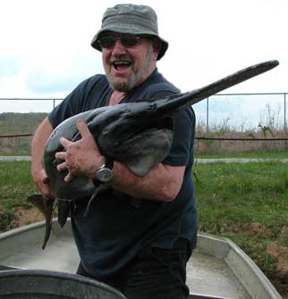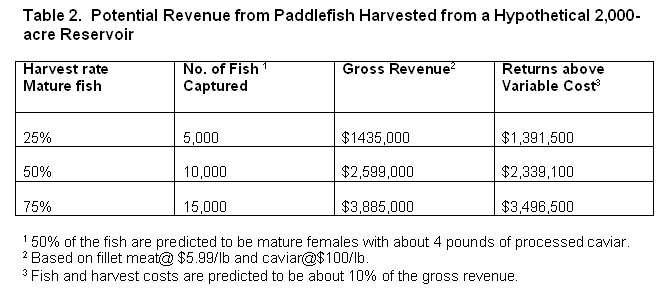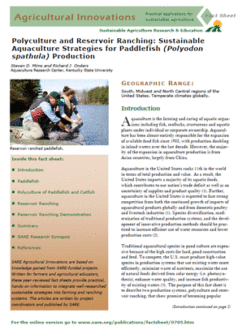
Reservoir ranching is an extensive, sustainable, non-polluting production system in which young fish (more than 12 inches in length) are stocked into lakes or reservoirs, permitted to forage on the natural food supply and harvested (7). They can be harvested as a meat fish after two or more years, or be permitted to grow to maturity of seven to nine years and harvested for their meat and roe. Paddlefish are usually over 10 pounds after two years, and females will usually reach maturity when the fish is over 30 pounds. To catch meat fish, 4- to 5-inch bar mesh gill nets will catch 10- to 30-pound fish. For catching mature females usually over 30 pounds, 6-inch bar mesh nets are best suited. Gill nets should be 150 feet long and 18 to 24 feet deep. They should be set perpendicular to the shore and left overnight if the water temperature is below 50°F. When the water temperature is over 50°F, nets need to be checked every couple of hours to prevent fish mortality.
Paddlefish can be stocked in lakes and reservoirs that are managed for sport fishes such as hybrid striped bass and walleye. They should not be stocked in reservoirs stocked with striped bass or tiger muskie, large predator fish that could consume them or could get entangled in gill nets at harvest. This system is very economical for paddlefish caviar production, requiring only the purchase of young fish, an existing body of water, seven to nine years of waiting for sexual maturity and harvesting.
Reservoir Ranching Demonstration
A reservoir ranching demonstration was implemented in 1996 using a private 68-acre "strip pit" reservoir (surface-mined for coal in the mid-1950s) in southern Indiana. Four hundred paddlefish were initially stocked. In the winter of 2004, 6-inch bar mesh gill nets (about a total of 900 feet) were set for two 24-hour periods. About 200 paddlefish averaging 33 pounds were captured. The fish were processed, providing about 1.75 tons of whole-dressed (de-headed and eviscerated) fish and 180 pounds of processed caviar. Another harvest from this reservoir in the winter of 2006 will be attempted to further assess survival. Initial cost of fish was $1,200 and harvest/processing costs were $3,600. Gross revenue was over $35,000 for the caviar sold at $150/pound and meat sold at $2.50/pound.
Pros and Cons of Reservoir Ranching in Large Reservoirs (>2000 acres)
Use of large reservoirs could permit large numbers (i.e. 20,000 fish in 2,000 acres) of paddlefish to be stocked for grow-out. At least half of the fish could be females, which would assist in generating revenue from a domestic supply of high-quality meat and caviar (Table 2). Paddlefish will not reproduce in static water, so the number of fish would never increase. Small family farms could produce and supply young paddlefish for stocking a local reservoir. Moreover, aquaculture infrastructure such as the hatchery and processing plant could increase employment in rural areas. At harvest, large mesh gill nets (6 inches in bar mesh) that are selective for large paddlefish will not capture most sport fish as long as the reservoir is not stocked with striped bass or tiger muskie. Some of the money generated from the harvest would sustain the program for re-stocking. Overall, the estimated economic impact from 2000 acres with 75 percent of the fish recovered is estimated to be around $7 million.

There are some disadvantages to using large reservoirs for paddlefish production. Most large reservoirs are considered public water and would have to be approved for production through government bureaucracy. Some reservoirs in the fall or during heavy rains have rapid draw downs to lower the water level that could permit the fish to escape. Poaching could be a possibility and would require better security around the reservoir. Total harvest is not possible, which would leave some of the large fish in the reservoir to be removed later.
Currently, there are no states that practice paddlefish reservoir ranching as a business in public waters. However, the Kentucky legislature mandated that its citizens be surveyed for their opinion on reservoir ranching of paddlefish in selected public reservoirs. The majority of the results (about 70 percent) gave positive acceptance by the public to permit this type of production with paddlefish. Recently, the Kentucky Department of Commerce started to evaluate the potential of a pilot project. For more information, email smims@kysu.edu
